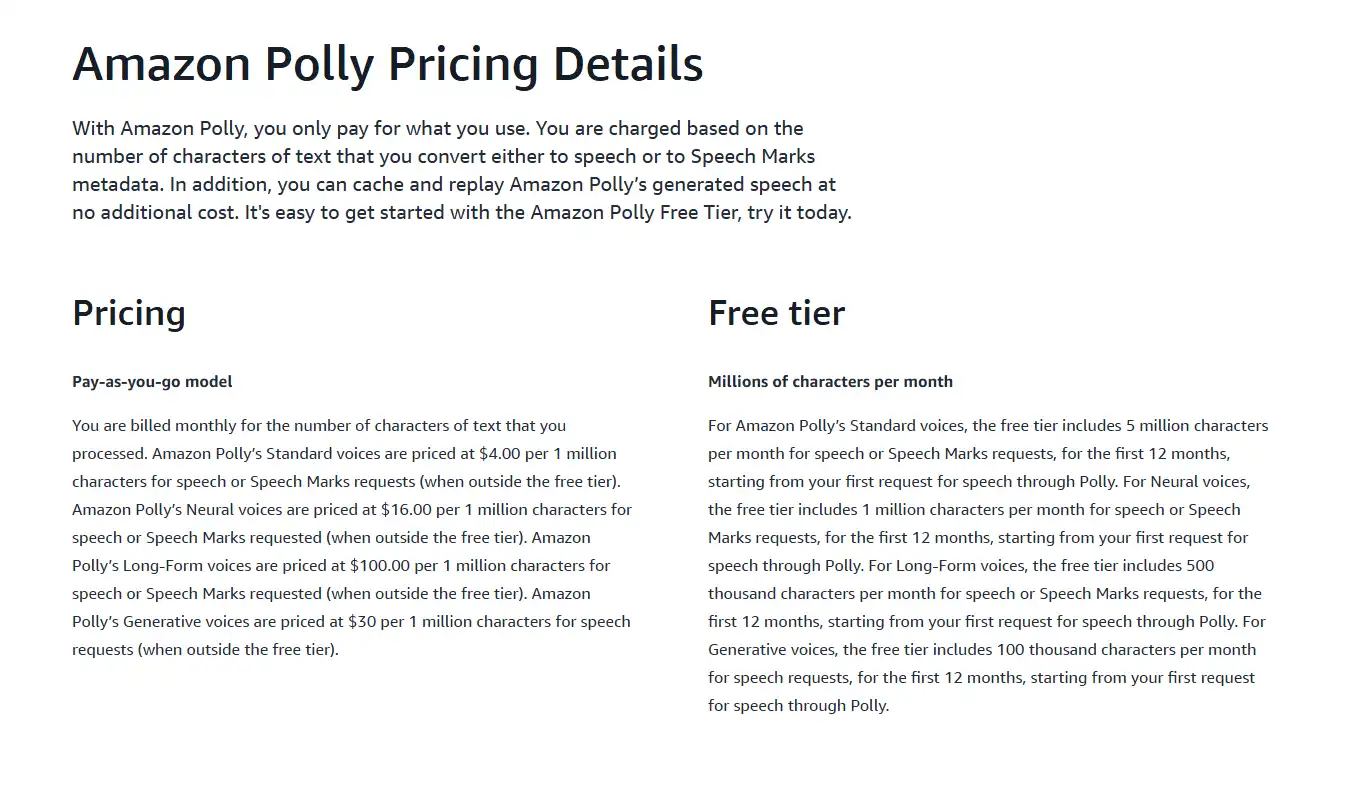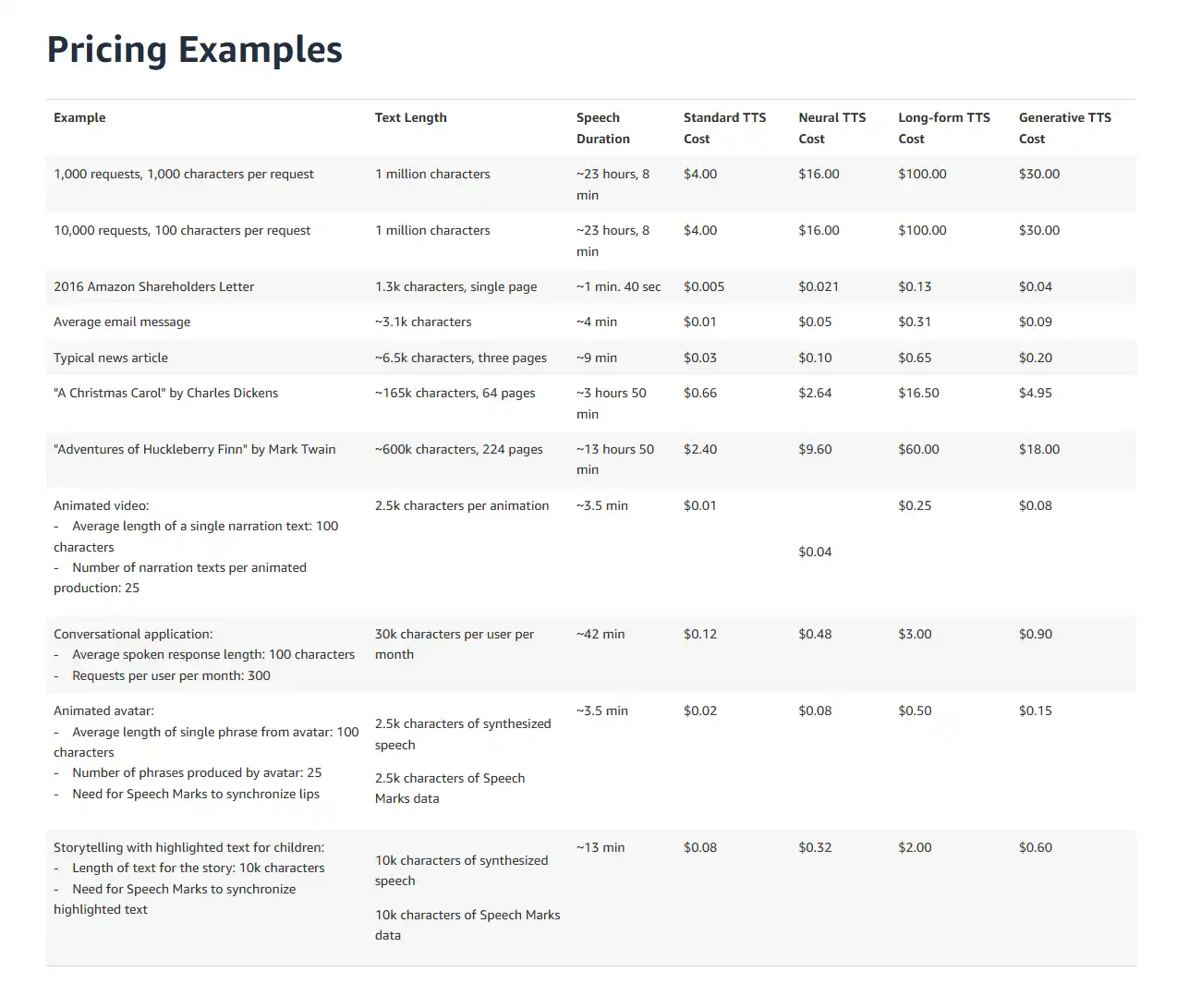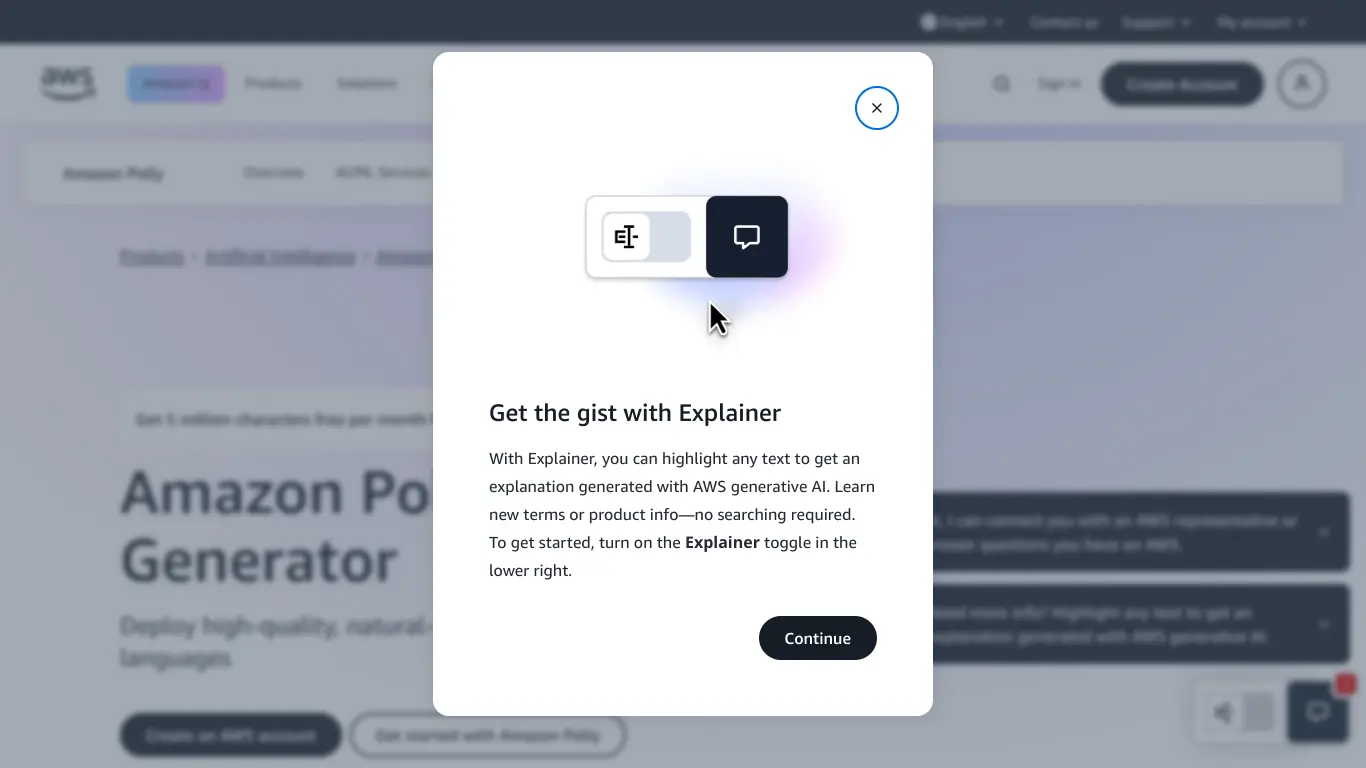Amazon Polly is a cloud-based service that converts text into natural-sounding speech with 60+ voices across 30+ languages.
Introduction to Amazon Polly
Are you tired of robotic text-to-speech voices that make your content sound unnatural and artificial? Perhaps you’re looking for a way to convert your written content into lifelike speech for accessibility purposes, e-learning platforms, or interactive voice response systems. If either of these scenarios resonates with you, Amazon Polly might be the solution you’ve been searching for.
What is Amazon Polly and its Purpose?
Amazon Polly is a cloud-based text-to-speech (TTS) service developed by Amazon Web Services (AWS) that converts written text into remarkably lifelike speech. Launched in 2016, this service uses advanced deep learning technologies to synthesize natural-sounding human speech, offering one of the most realistic and customizable voice experiences available in the market today.
The primary purpose of Amazon Polly is to enable developers and businesses to create applications that talk and build entirely new categories of speech-enabled products. It provides an API that allows you to easily integrate speech capabilities into your applications, regardless of where they’re hosted.
Unlike traditional TTS systems, Amazon Polly doesn’t just read text—it interprets it. The service analyzes text to determine the correct pronunciation of words, applies appropriate intonation and emphasis, and even handles complex linguistic nuances to deliver speech that sounds remarkably human.
Who is Amazon Polly Designed For?
Amazon Polly caters to a diverse range of users across various industries:
- Developers and Software Engineers: Those building applications that require voice capabilities, such as voice-enabled products or services.
- Content Creators and Publishers: Individuals or organizations looking to convert text-based content (articles, books, blog posts) into audio formats.
- Educational Institutions: Schools and universities creating accessible learning materials for students with reading disabilities or those who prefer auditory learning.
- Corporate Businesses: Companies developing interactive voice response (IVR) systems, customer service solutions, or internal training materials.
- Accessibility Advocates: Organizations focused on making digital content accessible to people with visual impairments or reading difficulties.
- Game Developers: Those looking to add realistic voice narration or character dialogue to gaming experiences.
- Media and Entertainment Companies: Broadcasting firms, podcasters, and content producers seeking to automate voice production.
Getting Started with Amazon Polly: How to Use It
Getting started with Amazon Polly is surprisingly straightforward, especially if you’re already familiar with AWS services. Here’s a step-by-step guide:
- Create an AWS Account: If you don’t already have one, sign up for an AWS account at aws.amazon.com.
- Access the Amazon Polly Console: Navigate to the AWS Management Console and select Amazon Polly from the list of services.
- Choose the Text-to-Speech Feature: On the Amazon Polly dashboard, select the “Text-to-Speech” tab.
- Input Your Text: Enter the text you want to convert to speech in the input field.
- Select a Voice and Language: Choose from over 60 voices across 30+ languages. You can select different voices based on gender, accent, and language.
- Customize Speech Marks (Optional): For advanced users, you can add SSML (Speech Synthesis Markup Language) tags to customize pronunciation, pauses, emphasis, and more.
- Generate and Listen: Click the “Generate Speech” button to convert your text. You can listen to the output directly in the console.
- Download or Stream: Finally, download the speech as an MP3 file or stream it directly to your application using the AWS SDK.
For developers wanting to integrate Polly programmatically, AWS provides comprehensive SDKs for popular programming languages including Python, Java, JavaScript, and more.
Amazon Polly’s Key Features and Benefits
Core Functionalities of Amazon Polly
Amazon Polly offers a robust set of features that set it apart from other text-to-speech services:
- Lifelike Voices: The most notable feature is its collection of remarkably natural-sounding voices. Amazon Polly offers over 60 lifelike voices across more than 30 languages, giving you plenty of options to find the perfect voice for your needs.
- Neural Text-to-Speech (NTTS): This advanced technology produces even more lifelike speech with improved intonation and emphasis. Neural voices can express emotions like happiness, excitement, and empathy.
- Standard Text-to-Speech: The standard voices offer reliable quality at a lower cost, perfect for larger-scale implementations.
- Speech Synthesis Markup Language (SSML) Support: This allows precise control over how Amazon Polly generates speech, including pronunciation, volume, pitch, rate, and more.
- Speech Marks: This feature returns information about the synthesized speech, such as sentence and word boundaries, which can be used for lip-syncing animations or highlighting text as it’s being read.
- Lexicons: You can upload custom pronunciation lexicons to ensure domain-specific terms, acronyms, or unusual words are pronounced correctly.
- Real-time and Batch Processing: Process text on-the-fly for interactive applications or in batch mode for generating large volumes of speech.
- Newscaster Speaking Style: Some neural voices support a newscaster speaking style, making them perfect for news content or formal announcements.
- Long-form Content Support: Amazon Polly can handle lengthy texts, making it suitable for audiobook creation or long article narration.
Advantages of Using Amazon Polly
Using Amazon Polly offers numerous benefits over other text-to-speech solutions:
- Exceptional Voice Quality: The neural voices especially stand out for their human-like quality, with natural intonation and rhythm that minimize the “robotic” feel of traditional TTS.
- Scalability: As an AWS service, Polly scales automatically with your needs, handling anything from occasional use to millions of requests.
- Cost-Effectiveness: With a pay-as-you-go pricing model, you only pay for the text you convert to speech, with no upfront costs or minimum fees.
- Consistent Performance: Being cloud-based, Polly delivers consistent performance without requiring powerful local hardware.
- Multilingual Support: With support for over 30 languages, Polly helps you reach global audiences without needing multiple TTS solutions.
- Easy Integration: Well-documented APIs and SDK support for multiple programming languages make integration straightforward.
- Security and Compliance: As part of AWS, Polly inherits AWS’s robust security features and compliance certifications.
- Regular Updates: Amazon continuously improves the service, adding new voices, languages, and features regularly.
- Low Latency: Fast response times make it suitable for interactive applications where immediate feedback is crucial.
Main Use Cases and Applications
Amazon Polly’s versatility makes it suitable for numerous applications across various industries:
- Content Accessibility:
- Converting written content into audio for visually impaired users
- Making educational materials accessible to users with reading disabilities
- E-Learning and Education:
- Creating engaging audio narration for online courses
- Developing language learning applications with native-sounding pronunciation
- Customer Service and Call Centers:
- Building interactive voice response (IVR) systems
- Generating automated customer service messages
- Media and Entertainment:
- Automating narration for news articles or blog posts
- Creating voice-overs for videos or animations
- Producing audiobooks from written content
- Gaming and Interactive Applications:
- Adding dynamic voice responses in video games
- Creating interactive storytelling experiences
- Healthcare Communication:
- Generating clear medical instructions for patients
- Providing multilingual health information
- Marketing and Advertising:
- Creating voice-overs for advertisements or promotional content
- Developing personalized audio messages for marketing campaigns
- Public Transit and Announcements:
- Generating clear announcements for transportation systems
- Creating automated public address system messages
Exploring Amazon Polly’s Platform and Interface
User Interface and User Experience
Amazon Polly’s interface is designed with both simplicity and functionality in mind, making it accessible to users with varying levels of technical expertise.
Console Interface:
The AWS Management Console provides a clean, intuitive interface for Amazon Polly with three main tabs:
- Text-to-Speech: The primary interface where you can input text, select voices, adjust speech rate, and generate audio. The real-time preview feature allows you to instantly hear how your text sounds with different voices and settings.
- Lexicons: This section allows you to manage custom pronunciation dictionaries, helping Polly pronounce specific terms, brand names, or acronyms correctly.
- SynthesizeSpeech API: For developers, this tab provides sample code and documentation for programmatic integration.
The console interface includes helpful features like:
- Voice sampling to compare different options
- SSML tags support with syntax highlighting
- Audio waveform visualization
- One-click download of generated audio
Developer Experience:
For those integrating Polly programmatically, AWS provides:
- Comprehensive documentation with code examples
- SDKs for popular programming languages
- Command-line interface (CLI) support
- Well-structured API responses
The developer experience is further enhanced by clear error messages, extensive logging options, and integration with other AWS services like CloudWatch for monitoring.
Platform Accessibility
Amazon Polly excels in platform accessibility in several key ways:
Cross-platform Compatibility:
Being a cloud service, Amazon Polly works seamlessly across different platforms:
- Web applications
- Mobile apps (iOS, Android)
- Desktop software
- IoT devices
- Serverless applications
Integration Options:
Amazon Polly can be accessed through multiple methods:
- AWS Management Console (web interface)
- AWS CLI (Command Line Interface)
- AWS SDKs (Software Development Kits) for languages including:
- Python
- Java
- JavaScript/Node.js
- .NET
- PHP
- Ruby
- Go
Accessibility Features:
True to its mission of making content more accessible, Polly itself offers features that make the service accessible to different users:
- Screen reader-compatible web console
- Keyboard navigation support
- High-contrast interface options
- Detailed documentation in accessible formats
Global Availability:
Amazon Polly is available in most AWS regions worldwide, ensuring low latency and regional compliance no matter where your users are located.
Amazon Polly Pricing and Plans
Subscription Options
Amazon Polly follows AWS’s flexible pay-as-you-go model, eliminating the need for traditional subscription plans. Instead, users pay only for the text they synthesize, making it cost-effective for both small-scale users and enterprise deployments.



Pricing Structure:
Amazon Polly offers two tiers of voices, each with different pricing:
- Standard Voices: These are the traditional text-to-speech voices that offer good quality at a lower price point.
- $4.00 per 1 million characters for speech or Speech Marks requests (first 1 million characters per month are free)
- Neural Voices: These premium voices use neural network technology to produce significantly more natural-sounding speech.
- $16.00 per 1 million characters for speech requests
- $4.00 per 1 million characters for Speech Marks requests
Additional Considerations:
- Long-term Storage: If you choose to store your synthesized speech files, standard AWS S3 storage rates apply.
- Data Transfer: Standard AWS data transfer rates apply if you’re transferring large volumes of audio files.
- Region Variations: Prices may vary slightly between different AWS regions.
Enterprise Agreements:
For large-scale enterprise users with predictable usage patterns, AWS offers Enterprise Agreements that can provide customized pricing based on volume commitments.
Free vs. Paid Features
Amazon Polly’s pricing model includes a generous free tier to help users get started without immediate costs:
Free Tier:
- 5 million characters per month free for Standard voices for the first 12 months
- 1 million characters per month free for Neural voices for the first 12 months
- This is part of the AWS Free Tier program
| Feature | Free Tier | Paid Tier |
|---|---|---|
| Standard Voices | 5M chars/month (first 12 months) | Unlimited usage at $4.00 per 1M chars |
| Neural Voices | 1M chars/month (first 12 months) | Unlimited usage at $16.00 per 1M chars |
| Available Voices | All voices accessible | All voices accessible |
| SSML Support | ✓ | ✓ |
| Speech Marks | ✓ | ✓ |
| Custom Lexicons | ✓ | ✓ |
| API Access | ✓ | ✓ |
| Long-form Audio | ✓ | ✓ |
| Technical Support | Basic support only | Premium support options available |
Cost Examples:
To put these prices in perspective:
- A typical novel of 80,000 words (approximately 400,000 characters) would cost $1.60 to synthesize with Standard voices
- The same novel with Neural voices would cost $6.40
- A 500-word blog post (approx. 2,500 characters) would cost just $0.01 with Standard voices
This pricing structure makes Amazon Polly particularly attractive for:
- Small businesses and startups with limited budgets
- Projects with unpredictable or irregular usage patterns
- Applications that need to scale quickly without renegotiating licenses
- Developers wanting to test and prototype without significant upfront costs
Amazon Polly Reviews and User Feedback
Pros and Cons of Amazon Polly
Based on analysis of user reviews and industry feedback, here’s a balanced assessment of Amazon Polly’s strengths and limitations:
Pros:
- Voice Quality: Users consistently praise the naturalness of Polly’s neural voices, with many noting they’re among the most human-like TTS voices available.
- Language Support: The broad coverage of languages and accents receives high marks, especially for organizations with global reach.
- Integration Ease: Developers frequently mention the straightforward API and comprehensive documentation as major advantages.
- Reliability: As part of AWS infrastructure, Polly’s uptime and consistent performance are highlighted as strengths.
- Scalability: Users appreciate the ability to scale from occasional use to millions of requests without service degradation.
- Cost Structure: The pay-as-you-go model with no upfront fees is widely viewed as fair and transparent.
- SSML Support: Advanced users value the extensive SSML support for fine-tuning pronunciation and expression.
Cons:
- Learning Curve: Some users report a steep learning curve, particularly for SSML and custom pronunciation lexicons.
- Emotional Range: While neural voices have improved significantly, some users note limitations in conveying complex emotions compared to human voice actors.
- Pricing for Neural Voices: Some feedback indicates that Neural voice pricing can become expensive for large-scale projects.
- Regional Limitations: A few voices and features are not available in all AWS regions, causing occasional frustration.
- Complex AWS Setup: New users sometimes find the overall AWS environment complex to navigate when first setting up Polly.
- Limited Voice Customization: Unlike some competitors, Polly doesn’t currently offer voice cloning or completely custom voice creation.
- Audio File Size: Some users mention that the generated audio files can be larger than expected for certain formats.
User Testimonials and Opinions
Here’s what real users are saying about Amazon Polly:
“We integrated Amazon Polly into our e-learning platform to narrate course content. The neural voices are remarkably natural—our students often forget they’re listening to synthesized speech. The multi-language support also allowed us to expand our courses globally without hiring voice actors for each language.” — Educational Technology Director
“As a developer of accessibility software, I’ve worked with numerous TTS services. Polly stands out for its consistency and natural-sounding prosody. The SSML support gives us precise control over how text is read, which is crucial for our users with visual impairments.” — Accessibility Software Engineer
“The AWS integration was seamless for our call center application. We use Polly to generate thousands of custom voice responses daily. The only drawback we’ve found is that very technical terms sometimes require custom lexicons to pronounce correctly.” — Call Center Solution Architect
“For our publishing company, Polly has been a game-changer in audiobook production. While it doesn’t replace human narrators for our premium titles, it’s perfect for quickly converting our backlist catalog into audio format at a fraction of traditional recording costs.” — Digital Publishing Manager
“We switched to Polly after trying three other TTS providers. The neural voices, especially Matthew and Joanna, are significantly more natural than competitors in the same price range. The main challenge was getting comfortable with the AWS ecosystem, but the quality was worth the effort.” — Mobile App Developer
Industry analysts have also noted Amazon Polly’s impact in the TTS market:
“Amazon Polly has raised the bar for TTS technology with its neural voices. The service exemplifies how deep learning can transform voice synthesis by capturing nuances of human speech that were previously impossible with rule-based systems.” — Tech Industry Analyst
The general consensus across reviews indicates that Amazon Polly is particularly strong for:
- Enterprise applications requiring reliability and scalability
- Multi-language projects
- Applications where voice quality directly impacts user experience
- Use cases requiring programmatic integration into larger systems
Amazon Polly Company and Background Information
About the Company Behind Amazon Polly
Amazon Polly is a product of Amazon Web Services (AWS), the cloud computing division of Amazon.com, Inc. Understanding the company behind this technology helps provide context for its development, support, and future direction.
Company Overview:
AWS launched in 2006 as Amazon’s cloud computing platform and has since grown to become the world’s most comprehensive and broadly adopted cloud provider. With millions of customers including fast-growing startups, large enterprises, and government agencies, AWS offers over 200 fully featured services from data centers globally.
Amazon Polly was introduced at the AWS re:Invent conference in November 2016 as part of AWS’s push into artificial intelligence and machine learning services. It joined other AI services like Amazon Rekognition (for image analysis) and Amazon Lex (for conversational interfaces) in AWS’s expanding AI portfolio.
Development Philosophy:
AWS follows Amazon’s customer-obsessed approach to product development. For Amazon Polly, this has meant continuous innovation based on customer feedback and needs:
- The initial launch featured 47 voices across 24 languages
- In 2019, AWS introduced Neural Text-to-Speech voices, dramatically improving naturalness
- Subsequent updates have added features like newscaster speaking styles, long-form content support, and additional languages
Leadership and Expertise:
Amazon Polly benefits from AWS’s deep bench of AI and machine learning expertise. The service is developed by teams including computational linguists, speech scientists, and machine learning engineers who continually refine the underlying models.
AWS’s AI services division is guided by strategic leadership focused on democratizing artificial intelligence technologies—making advanced capabilities accessible to developers without requiring specialized AI expertise.
Commitment to Ethics:
AWS has published responsible AI principles that guide the development of services like Amazon Polly. These include commitments to:
- Fairness and avoiding bias in AI systems
- Transparency about capabilities and limitations
- Privacy and security by design
- Continuous monitoring and improvement
Market Position:
As part of AWS, Amazon Polly benefits from:
- Integration with other AWS services
- AWS’s global infrastructure spanning 84 Availability Zones within 26 geographic regions
- Enterprise-grade security and compliance certifications
- AWS’s reputation for reliability and customer support
The service has become a significant player in the text-to-speech market, competing with offerings from other tech giants like Google (Text-to-Speech), Microsoft (Azure Cognitive Services), and IBM (Watson Text to Speech).
Amazon Polly Alternatives and Competitors
Top Amazon Polly Alternatives in the Market
If you’re evaluating text-to-speech solutions, it’s worth considering these leading alternatives to Amazon Polly:
- Google Cloud Text-to-Speech
- Website: https://cloud.google.com/text-to-speech
- Standout Features: Over 220 voices across 40+ languages, WaveNet technology for natural-sounding speech, extensive SSML support
- Best For: Android integration, companies already using Google Cloud
- Microsoft Azure Text to Speech
- Website: https://azure.microsoft.com/en-us/services/cognitive-services/text-to-speech/
- Standout Features: Neural voices with emotional styles, voice customization options, real-time streaming
- Best For: Enterprise customers, Microsoft ecosystem integration
- IBM Watson Text to Speech
- Website: https://www.ibm.com/cloud/watson-text-to-speech
- Standout Features: Expressive neural voices, voice transformation, customizable cadence and tone
- Best For: Complex enterprise applications, integration with Watson AI suite
- Elevenlabs
- Website: https://elevenlabs.io/
- Standout Features: Voice cloning technology, ultra-realistic voices, emotion control
- Best For: Creative content, personalized voice experiences, media production
- Play.ht
- Website: https://play.ht/
- Standout Features: User-friendly interface, voice cloning, direct publishing to platforms
- Best For: Content creators, podcasters, simple implementation
- Murf.ai
- Website: https://murf.ai/
- Standout Features: Studio interface for non-technical users, voice customization, collaborative tools
- Best For: Video creators, marketing teams, non-developers
- ReadSpeaker
- Website: https://www.readspeaker.com/
- Standout Features: Industry-specific voices, pronunciation customization, accessibility focus
- Best For: Education, healthcare, and accessibility applications
- Speechify
- Website: https://speechify.com/
- Standout Features: Mobile-first approach, document scanning, personalized reading experience
- Best For: Individual users, reading assistance, content consumption
Amazon Polly vs. Competitors: A Comparative Analysis
To help you make an informed decision, here’s how Amazon Polly stacks up against its top competitors across key factors:
| Feature | Amazon Polly | Google Cloud TTS | Microsoft Azure TTS | IBM Watson TTS | Elevenlabs |
|---|---|---|---|---|---|
| Voice Count | 60+ | 220+ | 110+ | 40+ | 25+ |
| Languages | 30+ | 40+ | 45+ | 20+ | 20+ |
| Neural Voices | ✓ | ✓ | ✓ | ✓ | ✓ |
| Voice Customization | Limited | Limited | Advanced | Advanced | Advanced |
| Voice Cloning | ❌ | ❌ | ✓ | Limited | ✓ |
| SSML Support | Extensive | Extensive | Extensive | Extensive | Basic |
| Emotions/Styles | Limited | Moderate | Advanced | Advanced | Advanced |
| Pricing Model | Pay-per-character | Pay-per-character | Pay-per-character | Pay-per-character | Subscription |
| Free Tier | 5M chars/month (Standard) | 1M chars/month | 0.5M chars/month | 10K chars/month | Limited samples |
| Integration Ease | ★★★★☆ | ★★★★☆ | ★★★☆☆ | ★★★☆☆ | ★★★★★ |
| User Interface | Developer-focused | Developer-focused | Developer-focused | Developer-focused | User-friendly |
| Best For | AWS users, scalable applications | Google Cloud users, multilingual apps | Enterprise, custom voices | Complex AI integration | Content creators, realistic voices |
Key Differentiators:
- Amazon Polly: Excels in AWS ecosystem integration, reliability, and developer-friendly implementation. Pricing is transparent and competitive, especially for Standard voices.
- Google Cloud TTS: Offers the largest selection of voices and languages. WaveNet voices provide excellent quality, especially for shorter content.
- Microsoft Azure TTS: Provides the most comprehensive emotional styling and voice customization options, making it ideal for varied content needs.
- IBM Watson TTS: Strong in enterprise environments and complex use cases, with excellent integration with other AI services.
- Elevenlabs: The newest entrant focuses on ultra-realistic voices and voice cloning technology, appealing to creative professionals and content creators.
Decision Factors:
When choosing between Amazon Polly and alternatives, consider:
- Existing Cloud Infrastructure: If you’re already using AWS, the seamless integration of Polly may outweigh minor advantages from competitors.
- Voice Quality Needs: For the most natural-sounding voices, compare samples from Polly’s neural voices against Elevenlabs and others with your specific content.
- Customization Requirements: If you need voice cloning or extensive emotional styling, Microsoft Azure or Elevenlabs may be better options.
- Technical Resources: Developer-heavy teams may prefer Polly’s API-first approach, while marketing teams might find Murf.ai or Play.ht more accessible.
- Usage Volume: For high-volume applications, Polly’s pricing model and scalability may offer advantages over subscription-based alternatives.
Amazon Polly Website Traffic and Analytics
Website Visit Over Time
Amazon Polly’s web traffic shows interesting patterns that reflect its position in the market and growing adoption of text-to-speech technology. Based on available analytics data:
📈 Traffic Trends (2020-2023):
- Overall Growth: Amazon Polly has seen steady traffic growth of approximately 18-22% year-over-year since 2020
- Seasonal Patterns: Notable traffic spikes occur after major AWS events and announcements
- Peak Periods: Highest traffic typically occurs during Q4 (Oct-Dec), coinciding with AWS re:Invent conferences where new features are announced
The service has seen particularly strong traffic growth following:
- The introduction of new neural voices
- The release of the newscaster speaking style
- Updates to the AWS free tier offerings
During the pandemic period (2020-2021), traffic showed accelerated growth as more businesses sought digital transformation solutions and remote learning tools that incorporated speech technologies.
Geographical Distribution of Users
Amazon Polly’s global reach is evident in its user distribution patterns, with strong representation across multiple regions:
🌎 Top User Regions by Traffic:
- North America: ~42% of total traffic
- United States: 35%
- Canada: 7%
- Europe: ~31% of total traffic
- United Kingdom: 9%
- Germany: 8%
- France: 6%
- Other European countries: 8%
- Asia-Pacific: ~18% of total traffic
- India: 7%
- Australia: 4%
- Japan: 3%
- Singapore: 2%
- Other APAC countries: 2%
- Other Regions: ~9% of total traffic
- Brazil: 3%
- Middle East: 3%
- Africa: 2%
- Rest of world: 1%
This distribution aligns with AWS’s global infrastructure and reflects higher adoption in regions with strong cloud computing presence. The service sees particularly strong engagement in urban tech hubs such as:
- San Francisco/Silicon Valley
- New York
- London
- Berlin
- Bangalore
- Sydney
Main Traffic Sources
Understanding how users discover and access Amazon Polly provides insight into its market positioning and user acquisition channels:
🔍 Traffic Sources Breakdown:
| Source | Percentage | Trend |
|---|---|---|
| AWS Console Direct | 36% | ↗️ Increasing |
| Organic Search | 28% | → Stable |
| Direct Navigation | 14% | → Stable |
| Referrals from AWS Docs | 11% | ↗️ Increasing |
| Social Media | 5% | ↗️ Increasing |
| Tech Blogs & News | 4% | → Stable |
| Other | 2% | ↘️ Decreasing |
Key Search Terms Leading to the Site:
- “Text to speech AWS”
- “Amazon TTS service”
- “Best text to speech API”
- “Neural TTS voices”
- “How to convert text to speech programmatically”
- “SSML examples AWS”
Most Common Referral Sources:
- AWS Documentation pages
- GitHub repositories with sample code
- Stack Overflow discussions
- Medium articles on voice technology
- YouTube tutorials on AWS services
The traffic patterns indicate that Amazon Polly has strong integration within the AWS ecosystem, with many users discovering the service after already using other AWS offerings. The increasing referrals from social media suggest growing awareness among non-technical users and content creators.
Frequently Asked Questions about Amazon Polly (FAQs)
General Questions about Amazon Polly
What exactly is Amazon Polly?
Amazon Polly is a cloud service that converts text into lifelike speech. It uses advanced deep learning technologies to synthesize natural-sounding human speech, allowing you to create applications that talk and build speech-enabled products.
How does Amazon Polly work?
Amazon Polly works by analyzing input text and using sophisticated neural networks and other techniques to generate synthesized speech. When you submit text through the API or console, Polly processes it, applies pronunciation rules, and returns an audio stream that you can play immediately or save for later use.
Do I need programming knowledge to use Amazon Polly?
Not necessarily. While programming knowledge is helpful for API integration, Amazon Polly provides a user-friendly web console where you can input text, select voices, and generate speech without coding. However, to integrate Polly into applications, basic programming skills are required.
What file formats does Amazon Polly support?
Amazon Polly can output audio in several formats including MP3, OGG (Vorbis), and PCM formats (including WAV). The format you choose depends on your application needs, with MP3 being the most common for general use.
Is Amazon Polly GDPR compliant?
Yes, Amazon Polly is designed to comply with GDPR. AWS offers a GDPR-compliant Data Processing Addendum (DPA), and Polly does not store the content of text requests you submit after processing is complete, unless you specifically configure it to do so.
Feature Specific Questions
What’s the difference between Standard and Neural voices?
Standard voices use traditional parametric text-to-speech technology, while Neural voices use advanced neural network-based approaches. Neural voices produce more natural-sounding speech with better intonation and emphasis, but they cost more and are available in fewer languages than Standard voices.
How many characters can I process at once?
Amazon Polly can process texts of up to 3,000 characters (or approximately 1,500 billable characters after removing SSML tags and other non-billable elements) in real-time mode. For longer texts, you can use the asynchronous synthesis option, which supports up to 100,000 billable characters per request.
What languages and voices does Amazon Polly support?
Amazon Polly currently supports over 60 voices across more than 30 languages, including English (US, UK, Australian, Indian accents), Spanish, French, German, Italian, Portuguese, Japanese, Korean, Mandarin Chinese, and many more. The voice catalog is regularly updated with new additions.
Can I customize how words are pronounced?
Yes, you can customize pronunciation in two ways: using SSML (Speech Synthesis Markup Language) tags within your text, or by creating custom lexicons—pronunciation dictionaries that help Polly correctly pronounce specialized terms, brand names, or acronyms.
Does Amazon Polly support different speaking styles?
Yes, some of Polly’s Neural voices support specialized speaking styles. For example, several English voices offer a “Newscaster” style that mimics the cadence and emphasis patterns of professional news anchuncers, making them ideal for news content or formal announcements.
Pricing and Subscription FAQs
How much does Amazon Polly cost?
Amazon Polly uses a pay-as-you-go pricing model based on the number of characters processed:
- Standard voices: $4.00 per 1 million characters
- Neural voices: $16.00 per 1 million characters
- Speech Marks: $4.00 per 1 million characters
New AWS customers can process up to 5 million characters per month for free with Standard voices for the first 12 months.
Are there any upfront costs or minimum fees?
No, there are no upfront commitments or minimum fees. You only pay for what you use, making it cost-effective for both small projects and large-scale implementations.
How does Amazon calculate billable characters?
Billable characters include all alphabetic, numeric, and special characters, punctuation, and spaces in your input text. SSML tags and certain white spaces are not counted as billable characters. Amazon provides a character counter in the console to help estimate costs.
Can I set usage limits to control costs?
Yes, you can set budgets and alerts using AWS Budgets to monitor your Polly usage and costs. You can also implement API throttling or quotas at the application level to limit usage.
Support and Help FAQs
What technical support options are available?
Amazon Polly is covered under standard AWS Support plans, which range from basic support (included with all AWS accounts) to premium options like Developer, Business, and Enterprise Support with progressively faster response times and more personalized assistance.
How do I report issues with voice quality or pronunciation?
You can report voice quality issues or pronunciation problems through the AWS Support Center. For pronunciation issues, consider first trying to address them using SSML tags or custom lexicons before contacting support.
Is Amazon Polly regularly updated with new features?
Yes, AWS regularly updates Amazon Polly with new voices, languages, and features. Major announcements typically happen during AWS events like re:Invent, but smaller updates occur throughout the year. You can stay informed through the AWS Blog and release notes.
Can I use Amazon Polly offline?
Amazon Polly is a cloud service that requires an internet connection for real-time processing. However, you can generate and download audio files in advance for offline use in your applications.
How do I get started with Amazon Polly?
To get started, create an AWS account, navigate to the Amazon Polly console, and try the text-to-speech functionality. For developers, review the documentation and sample code before integrating the API into your applications. AWS provides comprehensive getting-started guides for various programming languages.
Conclusion: Is Amazon Polly Worth It?
Summary of Amazon Polly’s Strengths and Weaknesses
After thoroughly examining Amazon Polly’s features, pricing, user feedback, and comparing it with alternatives, let’s summarize its key strengths and weaknesses to help you determine if it’s the right choice for your needs.
Key Strengths:
- Voice Quality: The neural voices particularly stand out for their natural-sounding speech, making Polly one of the leaders in TTS quality.
- AWS Integration: Seamless compatibility with other AWS services creates a powerful ecosystem for developers already using AWS.
- Scalability: From startup to enterprise-level traffic, Polly handles volume increases without performance degradation.
- Pricing Transparency: The pay-as-you-go model with a generous free tier makes costs predictable and often more economical than alternatives for many use cases.
- Developer-Friendly: Comprehensive documentation, multiple SDK options, and straightforward API implementation reduce development time.
- Reliability: As part of AWS infrastructure, Polly offers enterprise-grade uptime and performance consistency.
- Language Coverage: Support for over 30 languages makes it suitable for global applications.
Key Weaknesses:
- Limited Voice Customization: Unlike some competitors, Polly doesn’t currently offer voice cloning or completely custom voice creation.
- Technical Learning Curve: The AWS environment can be intimidating for non-technical users compared to more user-friendly alternatives.
- Cost for Neural Voices: While standard voices are cost-effective, neural voices at $16 per million characters can become expensive for large-scale projects.
- Emotional Range: Despite improvements, Polly still has limitations in conveying complex emotions compared to human voice actors.
- Regional Restrictions: Some features and voices aren’t available in all AWS regions, which can affect global deployments.
Final Recommendation and Verdict
Amazon Polly is worth it for:
- Developers and Organizations Already Using AWS: The seamless integration with existing AWS services creates significant efficiency advantages.
- Applications Requiring Scalability: The service handles everything from occasional requests to millions of conversions without performance issues.
- Projects with Varied Language Requirements: The extensive language support makes it ideal for multilingual applications.
- Cost-Sensitive Use Cases: For organizations mindful of budgets, the combination of free tier, pay-as-you-go pricing, and no upfront costs is compelling.
- Mission-Critical Applications: The enterprise-grade reliability makes it suitable for applications where consistent performance is essential.
Consider alternatives if:
- Voice Customization is Critical: If you need voice cloning or highly customized voices, solutions like Elevenlabs or Microsoft Azure might be more appropriate.
- You Need an All-in-One Content Creation Platform: For content creators wanting a complete solution without programming, platforms like Murf.ai or Play.ht may be more suitable.
- You’re Not Using Other AWS Services: If you’re not already in the AWS ecosystem, the value proposition might be less compelling compared to standalone solutions.
- Budget is Extremely Limited: While Polly is cost-effective, completely free alternatives might be better for hobbyist projects with zero budget.
Final Verdict:
Amazon Polly stands as one of the top text-to-speech services available today, particularly excelling in developer-focused implementations where quality, reliability, and scalability are priorities. Its position within the AWS ecosystem gives it distinct advantages for organizations already leveraging AWS services.
For most business applications—especially those requiring multilingual support, integration with other cloud services, or handling varying traffic loads—Amazon Polly provides an excellent balance of quality, features, and cost-efficiency. The continued innovation in neural voice technology suggests that Polly will remain at the forefront of text-to-speech services for years to come.
While not perfect for every use case, Amazon Polly’s strengths make it a recommended choice for the majority of text-to-speech implementation scenarios, especially those requiring enterprise-grade performance and developer-friendly integration.


















